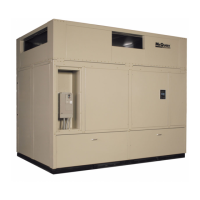42 McQuay IM 937
System Check, Test, and Start
To verify operation of the economizer when entering water is
unsuitable, place the water sensor in a cold water bath. Once
the sensor is in the bath, observe that the economizer control
valve is open. Readjust the control setting or remove the
sensor from the bath and observe that the economizer control
valve drives close.
Hot Water Start-Up
The hot water valve is modulated to maintain the discharge
heating set point. To verify the hot water valve operation,
adjust the heating set point through the keypad:
Heating
Zone Htg Spt=
Set the heating set point to a temperature greater than the
control temperature plus the dead band. Note the cooling set
point must be higher than the heating set point. With the
heating set point set properly, the hot water valve should
modulate open. To close the hot water valve, adjust the heating
set point below the control temperature minus the dead band.
After testing the hot water valve, return the heating set point to
its proper setting.
Expansion Valve Superheat Adjustment
It is very important that superheat is set properly. Under full
load conditions it should be between 10°F and 12°F. Lower
entering air conditions, lower airflow rates, and higher
condensing temperatures reduce the load on the expansion
valve. Under reduced load conditions, the superheat could be
as low as 6°F to 8°F. Insufficient superheat causes liquid
floodback to the compressor and possible liquid slugging.
Excessive superheat reduces system performance and shortens
compressor life. Verify that the sensing bulb is properly
located and securely strapped to the refrigerant line. See
Figure 41. Turn the adjusting stem clockwise to increase
superheat. Adjust the stem (one turn at a time, maximum) and
observe the superheat. Allow up to 30 minutes for the system
to rebalance at the final setting.
Refrigerant Charge
Each unit is designed for use with either R-22 or R-407C.
Units purchased with these specific refrigerants must use these
refrigerants only.
Units ship with a full operating charge of refrigerant and oil.
However, in the event of a leak in the system, some added
charge may be required. In an undercharged situation, any of
the following may occur:
• If a circuit is slightly undercharged, bubbles appear in the
sightglass.
• If a circuit is moderately undercharged, it may trip on its
frost protection sensor.
• If the circuit is severely undercharged, it may trip on its low
pressure safety.
If any of these conditions occur, first identify and correct the
source of the leak and then follow the charging procedure
described below.
Using the liquid line sight-glass as the sole means of metering
additional refrigerant charge into a self-contained unit, or any
AC unit, does not always provide the desired result.
Depending on the load conditions experienced by the
equipment during the charging process, adding refrigerant
until the sight-glass is clear of all bubbles may overcharge the
system and cause future operating issues. The better way to
charge a circuit is to use liquid subcooling and suction line
superheat as indicators, using the following procedure, which
should prevent overcharging of the circuit:
1 Verify that superheat is set per the “System Check, Test,
and Start” section on page 40.
2 Measure the discharge pressure reading and convert it to a
discharge temperature.
3 Measure and record the circuit’s liquid line temperature.
4 Measure and record the entering condenser water
temperature using the MicroTech III display.
5 Calculate liquid subcooling:
subcooling = discharge temperature – liquid line
temperature
6 If the calculated subcooling value is less than 8ºF, add
refrigerant.
7 Monitoring discharge pressure and liquid line temperature,
add refrigerant until the discharge temperature minus the
liquid line temperature is equal to 10ºF ± 2ºF. If the system
is running at light load conditions, subcooling should be at
the low end of the range. If the system is running near
design conditions, subcooling should be near the upper end
of the range.
8 Verify that superheat is still in the prescribed range.
CAUTION
Field mixing or changing of refrigerants can compromise
performance and damage equipment. Improper refrigerant
addition can cause equipment damage and severe personal
injury.
Units purchased for R-22 operation must be charged only with
R-22. Units purchased for R-407C operation must be charged
only with R-407C.
Table 15: Acceptable Refrigerant Oils
Polyolester [POE] oils
Note: Do not use mineral oils
Copeland ULtra 22 CC
Mobil EAL™ Arctic 22 CC
ICI EMKARATE RL™ 32CL

